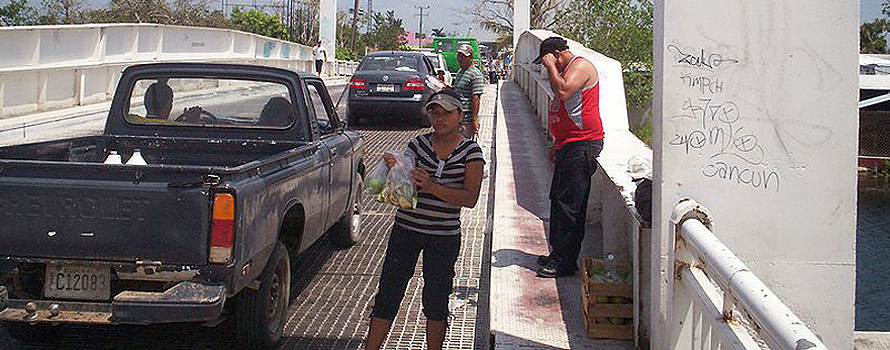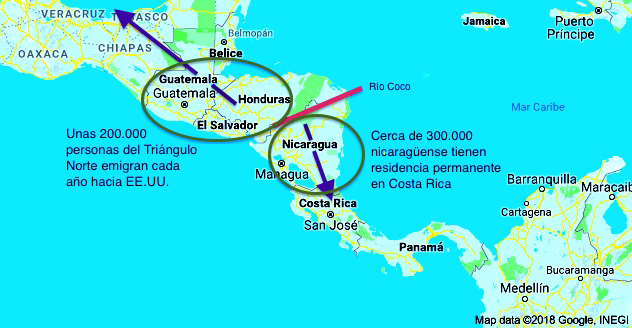Central America's Northern Triangle migrants look to the U.S., Nicaragua's to Costa Rica
While migrants from Guatemala, El Salvador and Honduras continue to try to reach the United States, those from Nicaragua have preferred to travel to Costa Rica in recent years. The restrictions put in place by the Trump Administration and the deterioration of the Costa Rican economic boom are reducing the flows, but this migratory divide in Central America remains for the time being.

▲Belize-Mexico border crossing [Marrovi/CC].
article / Celia Olivar Gil
When comparing the Degree of development of Central American countries, the different human flows operating in the region are well understood. The United States is the great migratory magnet, but Costa Rica is also to some extent a pole of attraction, obviously to a lesser Degree Thus, the five Central American countries with the highest poverty rates -Guatemala, El Salvador, Honduras, Nicaragua and Belize- share their migratory orientation: the first four maintain important flows to the United States, while in recent years Nicaragua has opted more for Costa Rica, given its proximity.
Migration from the Northern Triangle to the U.S.
Nearly 500,000 people try every year to cross Mexico's southern border with the goal of reaching the United States. Most of them come from Guatemala, El Salvador and Honduras, the Central American region known as the Northern Triangle, which is currently one of the most violent in the world. The reasons that lead this large issue of citizens from the Northern Triangle to migrate, many illegally, are varied:
On the one hand, there are reasons that could be described as structural: the porousness of the border, the complexity and high costs of regularization processes for migration, the lack of commitment by employers to regularize migrant workers, and the insufficient capacity of governments to establish migration laws.
There are also clear economic reasons: Guatemala, Honduras and El Salvador have a high poverty rate, at 67.7%, 74.3% and 41.6%, respectively, of their inhabitants. Difficulties in budgetary income and pronounced social inequality mean that public services, such as Education and healthcare, are poorly presentation to a large part of the population.
Perhaps the most compelling reason is the lack of security. Many of those leaving these three countries cite insecurity and violence as the main reason for their departure. The level of criminal violence in the Northern Triangle reaches levels similar to those of an armed conflict. In El Salvador, a total of 6,650 intentional homicides were registered in 2015; in Honduras, 8,035, and in Guatemala, 4,778.
All these reasons push Guatemalans, Salvadorans and Hondurans to migrate to the United States, who use three main routes to cross Mexico on their journey north: the one that crosses the country diagonally until reaching the Tijuana area , the one that goes through central Mexico to Ciudad Juarez and the one that seeks to enter the US through the Rio Bravo valley. Along these routes, migrants face many risks, such as falling victim to criminal organizations and suffering all subject of abuses (kidnapping, torture, rape, robbery, extortion...), which can not only cause immediate physical injuries and trauma, but can also leave serious long-term consequences.
Despite all these difficulties, citizens of the Northern Triangle continue to choose the United States as their migration destination. This is mainly due to the attraction of the economic potential of a country like the USA, in plenary session of the Executive Council employment status ; to its relative geographic proximity (it is possible to arrive by land crossing only one or two countries), and to the human relations created since the 1980s, when the USA began to be a goal for those fleeing the civil wars of a politically unstable Central America with economic difficulties, which created a migratory tradition, consolidated by family connections and the protection offered to the newcomers by the already established nationals. During this period, the Central American population in the U.S. tripled. Today, 82.9% of Central American immigrants in the U.S. live in the United States.
|

The American immigration 'watershed' [with ABC's authorization].
|
Migration from Nicaragua to Costa Rica
If emigration from northern Central America has been directed towards the United States, emigration from southern Central America has had more destinations. If Hondurans have looked north, in recent years their Nicaraguan neighbors have looked a little more to the south. The Coco River, which divides Honduras and Nicaragua, has become a sort of migratory'watershed'.
There are certainly more Nicaraguans officially residing in the U.S. (over 400,000) than in Costa Rica (close to 300,000), but in recent years the issue new residents has increased more in Costa Rican territory. In the last decade, agreement to an OAS report (pages 159 and 188), the U.S. has granted permanent residency program to average of 3,500 Nicaraguans each year, while Costa Rica has granted an average of 5,000, reaching a record 14,779 in 2013. Moreover, the proportional weight of Nicaraguan migration in Costa Rica, a country of 4.9 million people, is large: in 2016, some 440,000 Nicaraguans entered the neighboring country, and as many exits were recorded, indicating significant cross-border mobility and suggesting that many workers return temporarily to Nicaragua to circumvent immigration requirements .
Costa Rica is seen in certain aspects in Latin America as Switzerland in Europe, that is, as an institutionally solid, politically stable and economically favorable country. This means that the emigration of Costa Ricans is not extreme and that people come from other places, so that Costa Rica is the country with the highest net migration in Latin America, with 9% of the Costa Rican population of foreign origin.
Since its independence in the 1820s, Costa Rica has remained one of the Central American countries with the least amount of serious conflicts. For this reason, during the 1970s and 1980s it was a refuge for many Nicaraguans fleeing the Somoza dictatorship and the Sandinista revolution. Now, however, they do not emigrate for security reasons, since Nicaragua is one of the least violent countries in Latin America, even below Costa Rica's figures. This migratory flow is due to economic reasons: Costa Rica's greater development is reflected in the poverty rate, which is 18.6%, compared to Nicaragua's 58.3%; in fact, Nicaragua is the poorest country in the Americas after Haiti.
Likewise, Nicaraguans have a special preference for choosing Costa Rica as a destination because of its geographic proximity, which allows them to move frequently between the two countries and to maintain a certain degree of family coexistence; the use of the same language, and other cultural similarities.